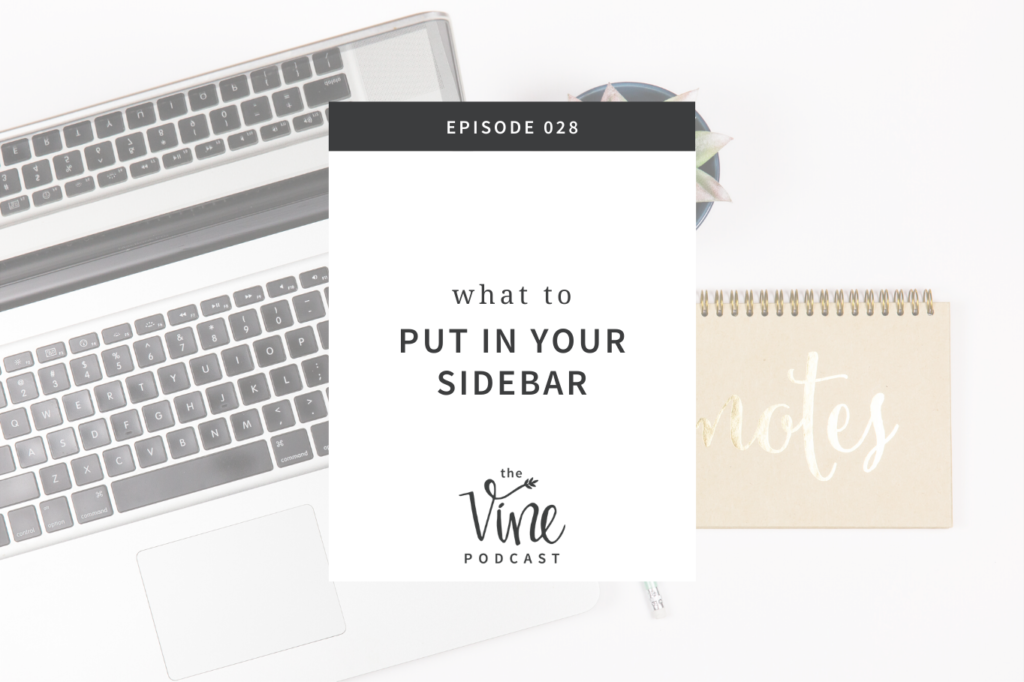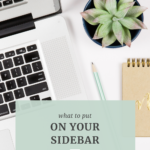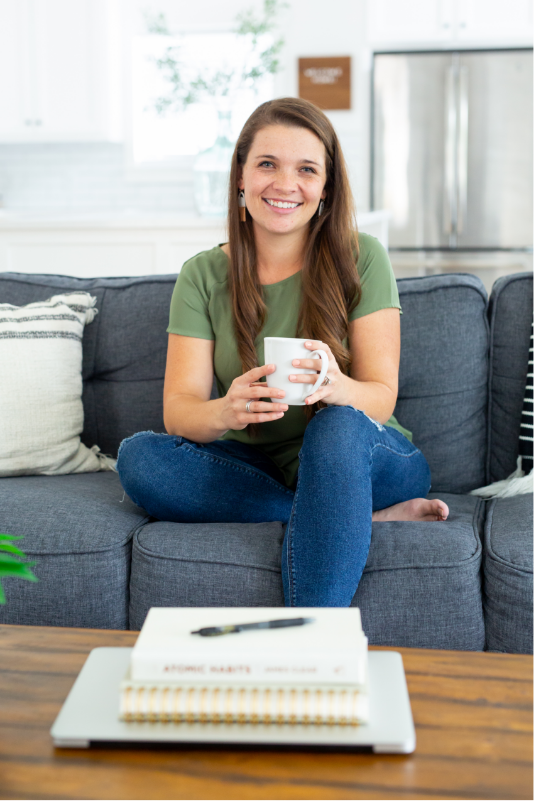How much time have you put into thinking about the elements that go on your blog sidebar? A well-designed sidebar can really increase engagement on your site and create a great user experience for your readers. In this episode, we’ll dive into what elements should be part of your sidebar so that you can make the most out of this space on your blog.


Can’t listen to the episode? Read on for the transcript!
You can think about your sidebar in one of two ways:
- It can be thought of as just a small part of your website that really doesn’t matter
- Or you can imagine it as being around one-fifth of the content or real estate space on almost every page of your blog.
If you’re listening to this episode, I’m guessing that you are curious about how you can maximize the use of that space and make sure that your sidebar is working hard for you.
What is the purpose of your sidebar?

The sidebar is an awesome part of your blog design that can enhance user experience and potentially increase engagement on your website. If you haven’t thought about your sidebar and maybe you just have these standard widgets that are kind of a part of the out of the box theme, then you could be missing a huge opportunity.
Your sidebar is another spot where strategy is really important. It’s not just a space to throw miscellaneous things that don’t have another place to go. It’s an opportunity to serve your users, to give them a clear call to action and to help your users navigate your website.
Remember that your sidebar is displayed on almost every page and even though it’s not front and center on mobile, that still leaves a huge population of your users who are going to see it and benefit from it on desktop.
It is on mobile. It’s just in a different spot, so it’s not like it’s completely useless on mobile. It just definitely is a bigger part of the desktop version of your website.
Think back to some of your strategic goals. We talked about that in episode 26, so go back to those strategic goals that you set and the foundation of where you’re trying to take your blog.
There should really be a purpose for everything that is on your sidebar. If you have an item there just because or because you couldn’t fit it anywhere else, then there’s a good chance that it shouldn’t be there in the first place.
Your sidebar offers a lot of flexibility, so think through what would make the most sense for your audience.
How to use your sidebar strategically
Let’s think back to that question of what your audience is struggling with and then trying to look at it from how can you use your sidebar as a space that serves them well.
Your sidebar is seen on almost every page. Most food blogs are designed with the sidebar there, and they’re not typically using a lot of full-width pages.

When you think about it from that perspective, what is something that you want almost every single user of your site to see? Those are the things that we’re going to talk about in terms of what you should put on your sidebar and really why the sidebar is such an important and yet often underthinked area of your blog.
You can think of these items that I’m going to mention in sort of two sections, the top half of your sidebar and the bottom half of your sidebar.
Every single website is totally different. So often I see food bloggers looking at other food bloggers to see what they should have on their website, but I want you to take what I’m saying with a grain of salt.
These are some of the best things to have on your sidebar, but they aren’t going to make sense for everyone. These are sort of the foundational items that I like to put on my client’s sidebars when I am designing a custom website for them or the things that I recommend to people when they come to me asking for some tips on website strategy.
The above the fold section of your sidebar
In that first top half of your sidebar, remember that this is the above the fold section of your sidebar. This is what someone is going to see immediately when they come to your site before they scroll.
This is the highest priority section of your sidebar because it’s what people are going to see first.
As you know, people like to scroll through your content rather quickly, trying to get down to the recipe card. The middle section, and even the bottom section, are going to be a little less important because they might be missed more often.
This first section is going to be something that they will always see regardless of if they use the jump to recipe button or scroll to the bottom of your recipe card in the top half of your sidebar.
Search Bar
You want to make sure that you have a search bar. I cannot even tell you how many times I have seen sites miss this. It’s getting a lot better over the last couple of years, but there have been so many times where I cannot find a sidebar on a food blog, and therefore I can’t use the website to find what I am looking for.
This obviously creates a horrible user experience for your readers, especially if this is a new reader. It’s really going to turn them away from your site, and most likely they won’t even bother scrolling to any other section of your website if they can’t find a search bar when they’re looking for one.
This should not be the only place that you have a search bar. If your sidebar is the only place that you have a search bar on your site, when someone comes to your site on mobile, they’re not going to be able to use that because it’s all the way at the bottom of your page.

It is definitely really important to have a search bar as part of your sidebar. However, don’t make that the only place that you have it on your website.
Image + Your Bio
The next part of your sidebar should be an image of you with a one to two sentence bio. This bio should not be your resume. It should not be your story completely, or the explanation of how you started your blog.
It should be short and sweet and to the point, and it really should help your audience see themselves in your story and in your blog. That should really help them feel right at home and know that this is the right place for them.
After that image of you and your short bio, you’re going to have a link to your about page so that someone can click over to that page and learn more about your blog, your story, and how they fit into it.
Social Media Links
The next section is going to be social media links. This is one of those areas that doesn’t always make sense for every blog. For the most part, people are using some form of social media, so this is a great spot to put those links so people can follow you on different social media channels.
This is a much better way to showcase those profiles than using your sidebar as an extension of those platforms and showing your feed from every single social media network that you are on.
Having those social media follow icons right there in your sidebar will help people who want to follow you on social media find those easily.
When you are choosing which ones to include, make sure that you’re only including the ones that you are active on and really trying to grow. If you have not posted on Twitter in three years, then don’t bother putting that on those social media links. If you’re active on Facebook and Pinterest and Instagram, then include those there.
This is also a great spot to put an icon for your contact information. You can put your email address right in there or even link that icon to your contact page if you are using a really well-done contact form.
Call To Action

I really believe that this should be one of two things:
- It should either be at your email list, sign up
- Or it should be a link or sort of a graphic or ad for a product or an ebook that you have.
This is something that you are trying to serve your audience well with, so make sure that it’s something that is strategic and helps them solve their problems. You don’t want it to be a generic signup form with no promise included in it.
If you have a paid product or even a free ebook, this is a great spot to put that because it’s going to help put you in the position of your audience immediately knowing that you were there to help them with their problem.
Especially if you have a paid product or even a free product that is really going to serve your audience well, use your sidebar to showcase that, and help people immediately associate you with someone who can help them.
The bottom half of your sidebar
Moving onto the bottom half of your sidebar. This is not content that is irrelevant or worthless to put here, I just order this by the importance of what I want to make sure that someone sees. You can usually fit those first four things above the fold if you are using a more tightly spaced design.
So this bottom half is going to be things that are still important, but if someone doesn’t see them when they first go to your site, it’s totally okay.
Relevant Content
You’re going to include relevant content in the bottom half of your sidebar. This could be things like linking to your most popular posts, which I mentioned in last week’s episode about designing your homepage.
You want to make sure that these are static links and not links that you’re changing very often. I’m not going to go too in-depth into the SEO implications for that, but just know that you want this to be something that sticks around for a good while. You don’t want to be changing on a monthly basis.
However, underneath those popular posts, you can have a section where you display posts from a specific category or highlight seasonal content or content that you might want to share every once in a while without having it be the static popular posts on every page.
This is one of those scenarios that is going to depend on the blog.
If you are using ads, you might not want to have all of this content on your sidebar because you want a shorter sidebar for a higher RPM on your ads.
So you have to take what I’m saying with a grain of salt and compare it to those goals that you have, and decide if having all of this content on your sidebar makes the most sense.
You might decide that you only want to have popular posts and not other posts displaying from a specific category or maybe you’re not working on growing your email list and you don’t have a product right now, and that’s okay. You don’t have to use that space for that email signup form.

You can prioritize something else that is more important to you and your goals right now. Think back to those goals and as you are thinking about these different options of elements to have on your sidebar, weigh the pros and cons of each of them and figure out if it makes sense to include it.
If you’re not sure, you can always test it out too. There are a lot of really great tools for testing things on your site, and things like heat maps where you can figure out if people are really clicking on those elements and if not, then it’s really simple to just remove them.
I’ve had a lot of people that have dug into those heat mapping tools and have found those things that they figured everyone was clicking on, in fact, nobody was clicking on or sometimes the opposite was true. When we were redesigning their website, they found out that there were some buttons that were being used heavily and so we made sure to keep those when we revised their website.
If you think back to the strategic goals, you can ask yourself if these elements are going to help you achieve those goals or if they’re going to get in the way of them.
For example, are you missing out on a connection with your audience by taking out your about image or the bio on your sidebar? Are you missing out on conversions by not having an email signup form?
If your goal is to connect with your audience, then you better have something on your sidebar for connection. If your goal is to make money, then you better have something to make money.
It doesn’t necessarily have to be an affiliate link or a spammy looking banner ad that isn’t going to convert well, but maybe you prioritize a shorter sidebar because of wanting to have those higher RPMs on your sidebar, or maybe you really highlight an affiliate product that you know your users really love and you use all the time.
If your goal is to help your audience find more content that is relevant to them, then using category banners displaying popular or seasonal content or showing them another way to browse your content is really important to include on your sidebar.
Recap
I hope that this episode has given you a few things to think about when it comes to designing your sidebar. This is an area that so often just gets overlooked or becomes an area to dump extra widgets or elements into when you don’t know where else to put them.
When you think about the fact that your sidebar is being seen by a huge percentage of your users and it’s taking up one-fifth of the space of your website on a desktop screen, then it becomes important to think about this area of your website strategically and capitalize on that real estate space with the most important items being showcased on almost every single page of your blog.
In next week’s episode, we’re going to be diving into the recipe index page of your blog, and I’m really excited for you to hear not only how important this page is, but also different ways that you can design it regardless of what theme you’re using or how your website is set up.





Leave a Comment